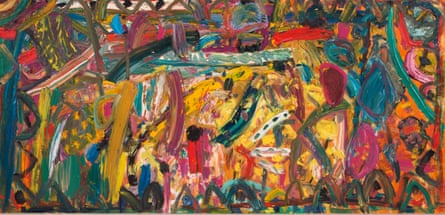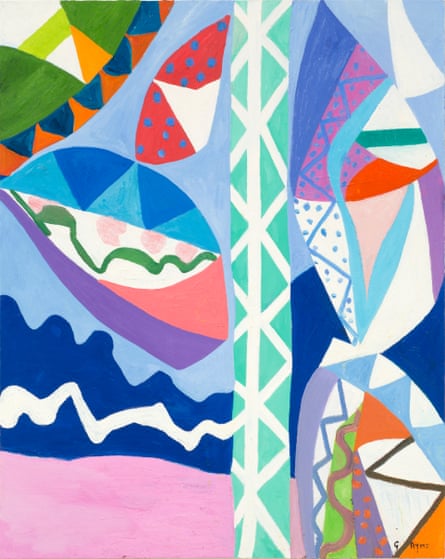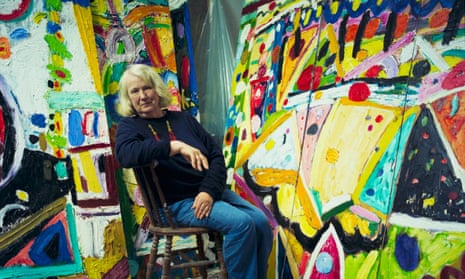Gillian Ayres, who has died aged 88, was one of Britain’s most significant abstract painters, a woman of much vitality and generosity, and a domestic person on a grand, overspilling scale. Her huge, improvised canvases, with paint sometimes an inch or two thick, were often worked on in sitting-rooms and bedrooms while Ayres’s bantams, peacocks, cats and dogs roamed freely from her garden to the kitchen to the studio. The marks of their paws and claws may still be detected in some paintings, for Ayres liked to drape wet, unstretched canvases over furniture and often painted on the floor.
She matured as an artist in the 1950s, in the heyday of “experimental art”. Her disobedient aesthetic sense helped her to become one of the first British admirers of Jackson Pollock. With Pollock in mind, but also instinctively, she formed pools of colour and spread-out lines, dashes and bravado meanderings. House paint was used on hardboard and her long formats resembled panels or friezes.
This tendency had its climax in a mural project of 1957. The architect Michael Greenwood asked Ayres to decorate the new dining hall at South Hampstead high school for girls, in north London. The resulting murals may count as the only true British contribution to American abstract expressionism. But their vigour went unappreciated. The murals were soon covered over - luckily, only with wallpaper. They were rediscovered, in almost perfect condition, in 1983, by which time Ayres had become famous.
Her public success had begun with the Hayward Annual in 1980, which was followed by a large exhibition at the Museum of Modern Art in Oxford in 1981 and a thrilling retrospective at the Serpentine Gallery in 1983. In the years to come she had regular shows at a number of dealers’ galleries, including Fischer Fine Art, Knoedler, Gimpel Fils and Alan Cristea. She was appointed OBE in 1986, advanced to CBE in 2011.
She became a Royal Academician in 1982; the Academy honoured Ayres with a retrospective in 1997. Not long afterwards, she resigned from the Academy when its Sensation exhibition included a portrait of the child murderer Myra Hindley, but in 2000 she was quite easily persuaded to rejoin. Most of her quarrels were short-lived and were the result of her warm-heartedness.

Gillian was born in south-west London, and grew up in Barnes, the only child of Florence and Stephen Ayres, who owned a factory that made smart hats. She attended St Paul’s school for girls, where a classmate was the future politician Shirley Williams. Ayres excelled in no academic subject and a precocious gift for landscape painting led to a place at Camberwell School of Art in 1946, at the age of 16.
It was then the most ladylike of London art schools, but Camberwell gave Ayres individual male friends. Howard Hodgkin, her equal in teenage self-will, was a cherished companion, then and in later years. There were also men who had come back from the army and would not accept instruction from traditionalists. One of them was Henry Mundy, whom she married in 1951.
Other lifelong friends who were ex-servicemen included Adrian Heath and Terry Frost, who had met in a PoW camp, and Frederick Gore. Ayres thus joined a group whose anti-authoritarian feelings helped form British abstraction in the 50s. Most of them were drawn to the anarchic example of Roger Hilton. In 1950-51 Ayres and Mundy painted together in Cornwall, not far from Hilton’s home, their efforts partly funded by Ayres’s work as a barmaid at the Gurnard’s Head pub near Zennor.

Back in London, Ayres and Mundy shared a job (three days each) at the AIA Gallery in Soho, which was an avant-garde but also a leftwing community project. Although she was never a political person, Ayres had a combative spirit. She mainly loathed artists of the Euston Road school, a detestation she maintained for the rest of her life. She thought that brown tonal paintings were an affront to the possibilities of life. Line-drawing meant little to Ayres, and she herself could hardly draw. She never spoke warmly of any contemporary portrait painting. Such attitudes encouraged her belief in the potential of abstraction.
In 1957 Ayres showed at the significant exhibition Metavisual, Tachiste, Abstract: Painting in England Today, at the Redfern gallery. She was the only woman in the Situation exhibition at the RBA Galleries in 1960, the first group show of British abstract art of the new decade. The predominant manner was of large paintings with clear outlines and flat colour. Ayres’s canvases nonetheless retained her characteristically ragged touch.
Although she showed at the Kasmin Gallery (1965, 1966 and 1969), the Situation exhibition was the end of her public career for some years. Ayres devoted herself to her two sons and to teaching. From 1959 until 1965, she was at the unusual Bath Academy of Art at Corsham. Other members of staff were Heath, Hodgkin, Frost and Mundy. Her husband was also her colleague when she taught at St Martin’s School of Art from 1966 until 1978. In 1976 she and Mundy divorced, although the fellow artists afterwards found it convenient to share a home for much of the rest of their lives.

In 1978, Ayres became the first woman to run a fine art department in a British art school, when she was appointed head of painting at Winchester. Some people thought that she was ill-equipped to chair committees, award degrees and make rational plans for cutting costs. It is true that she was not suited to discussions in an office. Ayres sincerely believed that an art school was most successful and creative without any office at all. Her resignation was accepted in 1981, with Ayres (in her view) the victim of a managerial tendency in art education. Despite these difficulties, she left Winchester with a thriving painting department.
Her own most creative period then began. She moved, with her family – and sometimes one or two other dependants, friends, or a penniless former student – to a remote house in the Llŷn peninsula in north Wales. The wooded mountains, rivers and nearness of the sea suited her romantic tendencies. Gigantic paintings, now in oil rather than acrylic, came very rapidly: sometimes she produced more than one a week. Her palette, sometimes floral, was also emphatic and lawless, with quantities of yellow. Some paintings became decorative, repeating their motifs, and she developed a series of round canvases. These were especially prized by collectors.

Ayres smoked 60 cigarettes a day, worked through the night if she felt like it, gave money to friends, neglected the washing up, collected broken pieces of pretty china and loved Elizabethan poetry. Her favourite painter was Rubens, whose sumptuous female models she somewhat resembled. Not seeing the point of putting cat food on a plate, she simply emptied the cans on to the kitchen floor. She never locked her car. Ayres ignored all advice, including medical advice. About government, current affairs and rational discussion she remained headily aloof.
She was therefore a splendidly disruptive personality in the many committees she was invited to join in the 80s. Ayres did not enjoy their meetings and was much happier when working directly with artists, devising exhibitions and co-operating with other painters in, for instance, India (where she spent some time as a representative of the British Council) and at the British School at Rome. Memories of these foreign trips may often be found in her paintings from that time.
From the late 80s Ayres painted in comparative seclusion from commerce and metropolitan life in the last, and most gloriously shabby, of her homes. This was on the north Devon coast near the border with Cornwall. For all her belief in abstraction, Ayres was still a painter who relied on rural British life.
In the almost inaccessible Gooseham, Ayres and Mundy worked in their separate studios until the skies darkened over their house, its mad allotments and the rushing stream, and the time had come for some champagne, uncorked by their helpful son Sam, who was also responsible for the organisation of two late Ayres retrospectives, one of her Welsh-period paintings at the Cardiff National Gallery and, in Beijing, a more general account of her work, both in 2017-18.
She is survived by her two sons with Mundy, Jimmy and Sam.

Comments (…)
Sign in or create your Guardian account to join the discussion